KYOTO • A 400-year-old temple in Japan is attempting to hot-wire interest in Buddhism with a robotic priest that it believes will change the face of the religion despite critics comparing the android to "Frankenstein's monster".
The android Kannon, based on the Buddhist deity of mercy, preaches sermons at Kodaiji temple in Kyoto, and its human colleagues predict that with artificial intelligence (AI), it could one day acquire unlimited wisdom.
"This robot will never die, it will just keep updating itself and evolving," priest Tensho Goto told Agence France-Presse.
"That's the beauty of a robot. It can store knowledge forever and limitlessly. With AI, we hope it will grow in wisdom to help people overcome even the most difficult troubles. It's changing Buddhism," added Mr Goto.
The adult-sized robot was put into service earlier this year and is able to move its torso, arms and head. But only its hands, face and shoulders are covered in silicone to replicate human skin.
Clasping its hands together in prayer and speaking in soothing tones, the rest of the droid's mechanical parts are clearly visible.
Wiring and blinking lights fill the cranial cavity of its open-top head and snake around its gender-neutral, aluminium body. A tiny video camera installed in the left eye completes an eerie, cyborg-like frame seemingly lifted straight out of a dystopian Hollywood sci-fi thriller.
Developed at a cost of almost US$1 million (S$1.38 million) in a joint project between the Zen temple and renowned robotics professor Hiroshi Ishiguro at Osaka University, the humanoid - called Mindar - teaches about compassion and of the dangers of desire, anger and ego.
With religion's influence on daily life flat-lining in Japan, Mr Goto hopes Kodaiji's robot priest will be able to reach younger generations in a way traditional monks cannot.
"It might be difficult to relate to fuddy-duddy priests like me, but hopefully the robot is a fun way to bridge that gap. We want people to see the robot and think about the essence of Buddhism."
Mr Goto insisted, however, that Mindar was no gimmick to boost income from tourists.
The pious droid delivers sermons from the Heart Sutras in Japanese, with translations in English and Chinese projected onto a screen.
Kodaiji temple has also faced criticism before, mostly from foreigners, for tampering with the sanctity of religion.
"Westerners have been the most upset by the robot," said Mr Goto, noting largely positive feedback from Japanese visitors.
"It could be the influence of the Bible, but Westerners have compared (the robot) to Frankenstein's monster," he added.
"Japanese people don't possess any prejudices against robots. We were brought up on comics where robots are our friends. Westerners think differently."
The temple insists the deity of mercy is able to transform itself at will and that an android is merely the latest incarnation.
"Artificial intelligence has developed to such an extent we thought it logical for the Buddha to transform into a robot," said Mr Goto.

